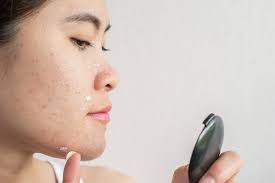
Can You Use Azelaic Acid for a Sunburn? Here’s What You Should Know
When your skin gets sunburned, it’s inflamed, sore, and in urgent need of healing. You may wonder whether soothing ingredients like azelaic acid can help.
Known for treating acne and rosacea, azelaic acid is loved for its skin-friendly, non-irritating nature. But does that mean it’s safe for sunburned skin? Let’s take a closer look.
What is Azelaic Acid?
Azelaic acid is a naturally occurring dicarboxylic acid. It’s derived from grains like barley, wheat, and rye. Though it sounds intense, it’s actually quite gentle.
It’s often recommended by dermatologists for treating:
Acne and rosacea
Redness and inflammation
Post-acne marks and dark spots
Uneven texture and tone
Azelaic acid has antibacterial and anti-inflammatory properties, which is why it works well for acne and rosacea. It unclogs pores, reduces bacteria, and calms redness.
You’ll find it in over-the-counter products (usually 10%) and in prescription strengths (up to 15-20%), often formulated as creams, gels, or foams.
Not only does it fight acne and soothe irritation, but it also improves skin texture, refines pores, and helps fade pigmentation left behind by breakouts.
All in all, it’s a versatile, effective skincare ingredient.
Is Azelaic Acid Sun-Sensitive?
Surprisingly, azelaic acid is not sun-sensitive, unlike most other exfoliating acids like glycolic or salicylic acid.
This means you can use it in the morning without worrying about immediate UV damage, although sunscreen is still absolutely necessary.
Even though azelaic acid doesn’t react with sunlight, it still exfoliates the skin mildly. This means newer skin cells are exposed, and those are more vulnerable to sun damage.
Without SPF, these fresh skin cells can become dehydrated, inflamed, or pigmented. So always pair azelaic acid with a broad-spectrum sunscreen of SPF 30 or higher.
Can You Use Azelaic Acid on Sunburned Skin?
In short: No, it’s not recommended to use azelaic acid on sunburned skin.
Though gentle compared to many other acids, azelaic acid still has exfoliating properties. Sunburned skin is already inflamed, dry, and damaged, so exfoliation should be avoided.
Using azelaic acid on sunburn could make the condition worse by increasing sensitivity, redness, and dryness. It may delay healing and irritate already fragile skin.
Instead, focus on calming, hydrating treatments until your skin has fully recovered. Once the skin is healed, you can safely reintroduce azelaic acid into your routine.
Which Acids Are Safe for Sunburn?
You might assume all acids should be avoided on sunburn—and you’d be mostly right. But there’s one exception: hyaluronic acid.
Despite its name, hyaluronic acid is not an exfoliating acid. It’s a hydrating humectant, which means it draws water into the skin and keeps it there.
Using a cool hyaluronic acid serum on sunburned skin can help reduce tightness and soothe inflammation. For extra comfort, store it in the fridge before applying.
This hydration will support the skin’s natural repair process and help prevent excessive peeling or flaking.
What You Should Avoid When You Have Sunburn
Caring for sunburned skin requires patience and the right choices. Here are things to avoid during the healing process:
1. Tight Clothing
Tight fabrics can rub against burned skin, worsening irritation. Wear loose, breathable materials to allow air to circulate and prevent further damage.
2. Petroleum Jelly (Too Soon)
While it can lock in moisture, petroleum jelly traps heat too. Wait until your skin cools completely before applying it. Otherwise, it can make burns feel hotter and more painful.
3. Exfoliants of Any Kind
Avoid all chemical exfoliants, including glycolic acid, salicylic acid, retinol, and even gentle scrubs. Exfoliating too soon will delay healing and increase irritation.
4. Scratching or Peeling Flaky Skin
Resist the urge to peel or scratch. Instead, apply a gentle hydrating product, such as aloe vera or a fragrance-free moisturizer, to ease discomfort and support healing.
5. Forgetting to Hydrate
Drink plenty of water throughout the day. Hydration is essential for skin recovery from sun damage. It keeps cells functioning properly and speeds up healing.
Is It Bad to Use Salicylic Acid on Sunburned Skin?
Yes, it is. Salicylic acid, while great for treating acne, is too harsh for damaged, sunburned skin.
It penetrates deep into the pores, breaking down oil and dead skin. But on sunburned skin, this can lead to dryness, increased peeling, and more redness.
Also, when the skin barrier is weakened, salicylic acid may trigger overproduction of sebum as your skin tries to compensate for water loss. This can lead to breakouts.
Hold off on using salicylic acid until your skin is fully healed and no longer red, flaky, or inflamed.
Does Azelaic Acid Help with Redness?
Yes, azelaic acid is fantastic for reducing redness, especially from conditions like rosacea, acne, or post-inflammatory marks.
Its anti-inflammatory effects help calm the skin and soothe flare-ups, which is why it’s often prescribed to those with sensitive or reactive skin.
However, while it reduces chronic or ongoing redness, it’s not designed for sunburn-induced redness, which is caused by UV damage and heat, not inflammation from within.
Using azelaic acid during a sunburn flare-up won’t give you the same calming results—and may even make it worse.
How to Treat Sunburn Safely and Effectively
If you’re dealing with sunburn, here’s a simple routine to follow:
Cool the Skin Immediately
Take a cool (not cold) shower or use a damp towel to gently cool the area. This reduces inflammation and eases the burning sensation.
Apply Aloe Vera or After-Sun Gel
Use gels or creams with soothing ingredients like aloe vera, chamomile, or calendula. These help reduce discomfort and promote healing.
Use Hydrating Products
Moisturizers with hyaluronic acid, glycerin, or ceramides help rebuild the skin barrier and replenish moisture lost from UV exposure.
Avoid Fragrance or Alcohol-Based Products
These can sting and irritate sensitive, sun-damaged skin. Stick with fragrance-free, gentle formulations only.
Drink Extra Water
Sunburn dehydrates the skin and body. Drink more water than usual to keep your skin cells healthy and aid recovery.
Protect the Area from Further Sun Exposure
Stay indoors or wear sun-protective clothing if you must go outside. Reapply SPF generously every two hours once your skin is healed.
When Can You Reintroduce Azelaic Acid After a Sunburn?
Wait until your skin:
No longer feels warm to the touch
Has stopped peeling
Looks and feels normal again
Once those signs are gone, you can slowly add azelaic acid back into your routine. Start with small amounts and monitor for any reactions.
To be safe, use it only once every few days until your skin rebuilds full tolerance.
In Summary: Should You Use Azelaic Acid on Sunburn?
No, azelaic acid is not suitable for use on sunburned skin.
It’s gentle, but it still exfoliates and can worsen damage on burned skin.
Focus on hydration, cooling, and barrier repair until your skin is healed.
Once recovered, azelaic acid can help treat post-sun damage like dark spots or texture.
Always use SPF alongside azelaic acid to prevent future burns or irritation.
Final Tip: Prevention Is Better Than Cure
The best way to treat sunburn is to prevent it entirely. Make broad-spectrum SPF your daily habit, even on cloudy days.
Use sun-protective clothing, reapply sunscreen frequently, and seek shade whenever possible.
Your skin will thank you not only today—but years from now, too.


